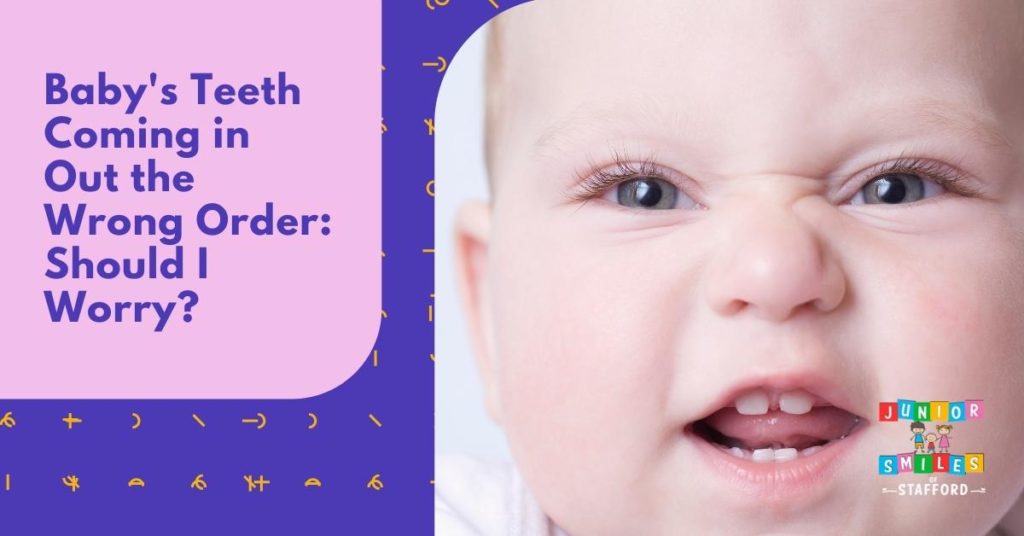Baby’s Teeth Coming Out in the Wrong Order: Should I Worry?

Parents never want to miss anything from the first step, first word, first word, first smile–even after noticing their first tooth visible. Every first of a baby is considered a milestone, and everyone is excited to witness it. Also, oral health is not something you can neglect. Moreover, the emergence of baby teeth is a part of a child’s regular growth. When your child is three years old, they will have a total of 20 teeth! The majority of a child’s primary teeth erupt within the first two years of their life.
However, this process does not always proceed as planned. A delay in the emergence of your baby’s teeth could indicate that something is amiss. Continue reading this blog to know more about your baby’s baby teeth.
Tooth Eruption Order
In the first three years, your child will have five different types of teeth. This is the sequence in which your baby’s teeth will erupt.
- Front teeth or central incisors
- Between the central incisors and canines or lateral incisors
- First molars
- Beside the front molars or the canines
- Second molars.
However, if your baby’s teeth slightly did not follow the order, you should not usually worry about it. Although, most often, babies’ central incisors (bottom front teeth) are typically the first teeth to erupt in a baby.
Timing
Some babies are born with one or more teeth–genetics can play a big part. This is how it works: If you or your partner got your baby teeth early, it’s likely that your child will, too. Moreover, you must note that teething is different for each child. There are cases where some babies start to get their first couple of teeth as soon as 4 to 7 months old, while others don’t get their first teeth until nine months old, or sometimes until they’re one year old.
You can keep track of your child’s teething progress every four months. There might be different eruptions, but here’s the general timeline you can keep in mind:
- 6-10 months: bottom central incisors
- 8-12 months: top central incisors
- 9-13 months: top lateral incisors
- 10-16 months: bottom lateral incisors
- 13-19 months: first molars in top of the mouth
- 14-18 months: first molars on the bottom
- 16-22 months: top canines
- 17-23 months: bottom canines
- 23-31 months: second molars on bottom of the mouth
- 25-33 months: second molars on top
Baby Teeth Not Coming Out In Order
There are cases where teeth can erupt later than usual or earlier than expected, even as early as four months of age–and that is entirely normal as every baby has unique qualities and different timetables.
Moreover, it’s also possible that your baby’s teeth will come out in a different way than what’s normal. Your child’s upper teeth in front might erupt first. Then there’s no need to be afraid. By their third birthday, your child should have a set of 20 teeth that are in good shape.
However, there might also be possible complications in your baby experiencing improper tooth eruption. As an example, if the permanent teeth aren’t in the right place, it can change how far apart the permanent teeth are. When this happens, make sure to get in touch with your pediatric dentist as soon as possible to prevent long-term effects from occurring.
When To Talk To A Pediatric Dentist
Teething problems are more common in babies born prematurely and those who don’t have enough medical care. The American Academy of Pediatrics says that if your child hasn’t had any teeth come in by the age of 18 months, you should see a dentist. All babies should start going to the dentist soon after they turn one.
Around six years old, most kids get their first set of permanent teeth. They usually start with the bottom central incisors then move on to the next set of teeth. If you think your baby’s teeth are coming in too close together, you should talk to a pediatric dentist.
Moreover, make sure to get in touch with your pediatric dentist as soon as any of these issues arise. If you want healthy teeth for your baby, make sure to prevent any future risks.
- gingivitis
- feeding difficulties
- cavities
- brown or yellow spots on teeth
- cellulitis
- infections
- early tooth loss
- tooth decay
Always communicate with your dentist as babies are more prone to baby tooth decay.
Read Next: What to Expect At Your Toddler’s First Dental Appointment
Contact Junior Smiles of Stafford to learn more about your child’s baby teeth
Are you worried that there might be complications since your child’s teething is not in order? Get in touch with a pediatric dentist immediately. Our goal is to make your child’s dental appointments a pleasant and stress-free experience.
Read Next: What Happens When Baby Teeth Don’t Fall Out and New Teeth Come In?
Why Choose Junior Smiles of Stafford?
Our Stafford, VA team is well-versed in working with clients of various ages and backgrounds. They’ll take the time to get to know you and your family’s requirements, and they’ll work with you to design a treatment plan that suits your schedule. Sealants and fluoride treatments are just two of the many preventative care options we provide to keep your mouth healthy.
About Us
Visiting Junior Smiles of Stafford means you’re in good hands when it comes to receiving high-quality care. Your child’s dental health improves with each visit, ensuring a brighter smile for years to come. We adhere to the ADA and AAPD’s guidelines for best practices.
Where Are We Located?
Phone: (540) 699-2441
Fax: (540) 699-2464
Email: info@juniorsmilesofstafford.com
Monday and Tuesday: 9:00 AM – 5:00 PM
Wednesdays and Thursdays: 8:00 AM – 4:00 PM
Fridays and Saturdays: 9:00 AM – 2:00 PM (By appointment only)
How to Book Your Kids First Appointment at Junior Smiles of Stafford
Fill out the form on our website. Within 24 hours, a member of our team will get back to you.

